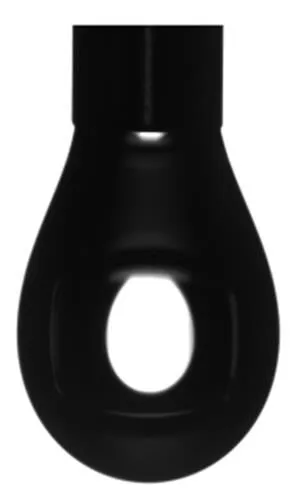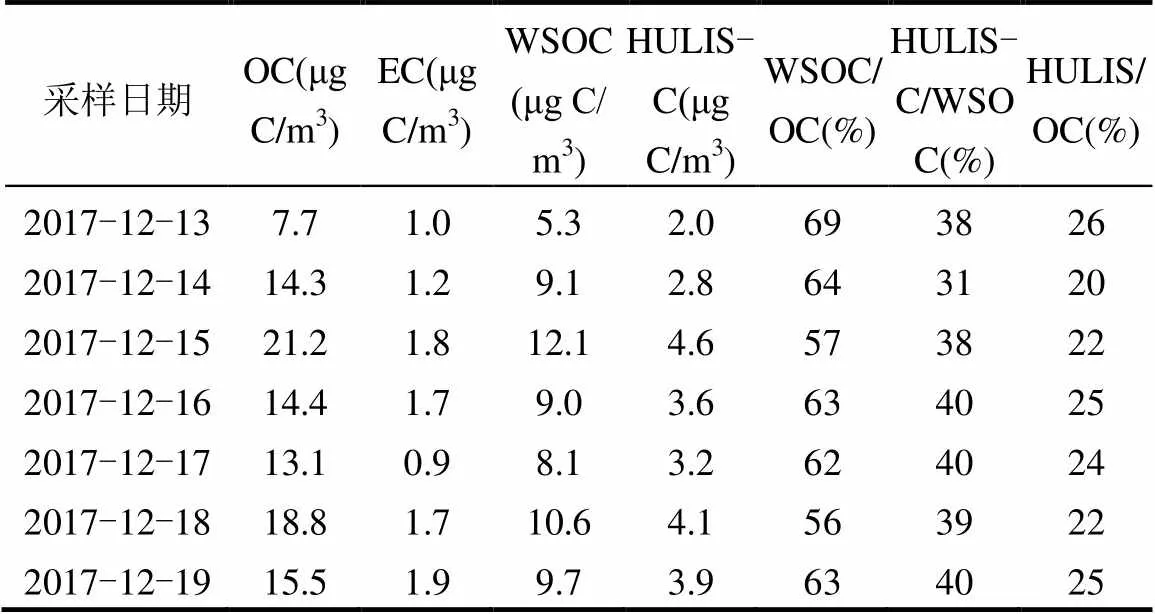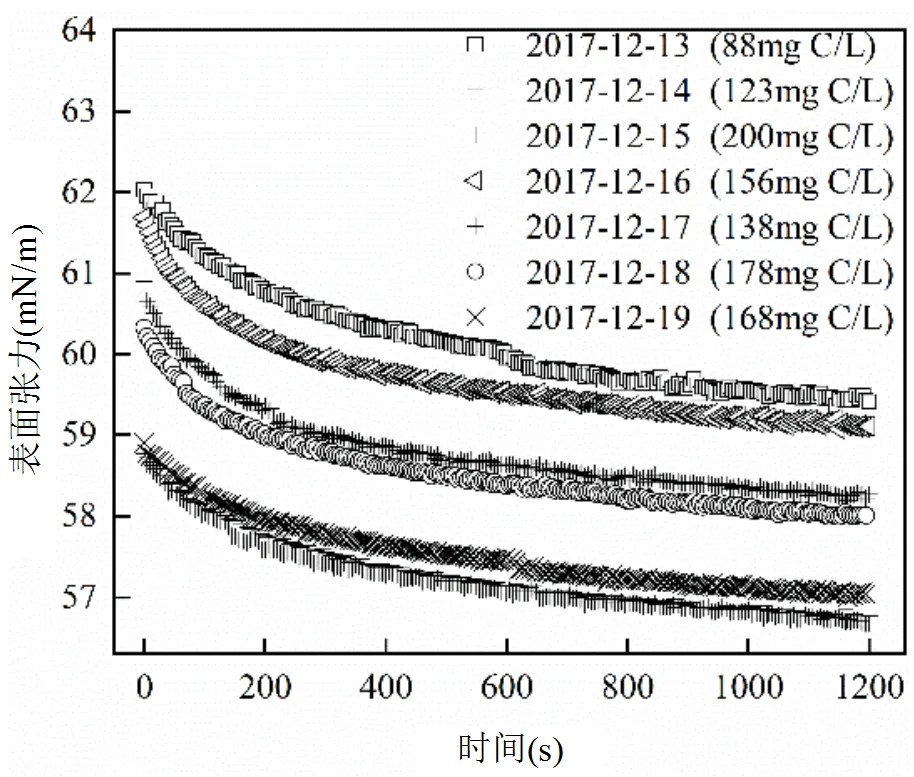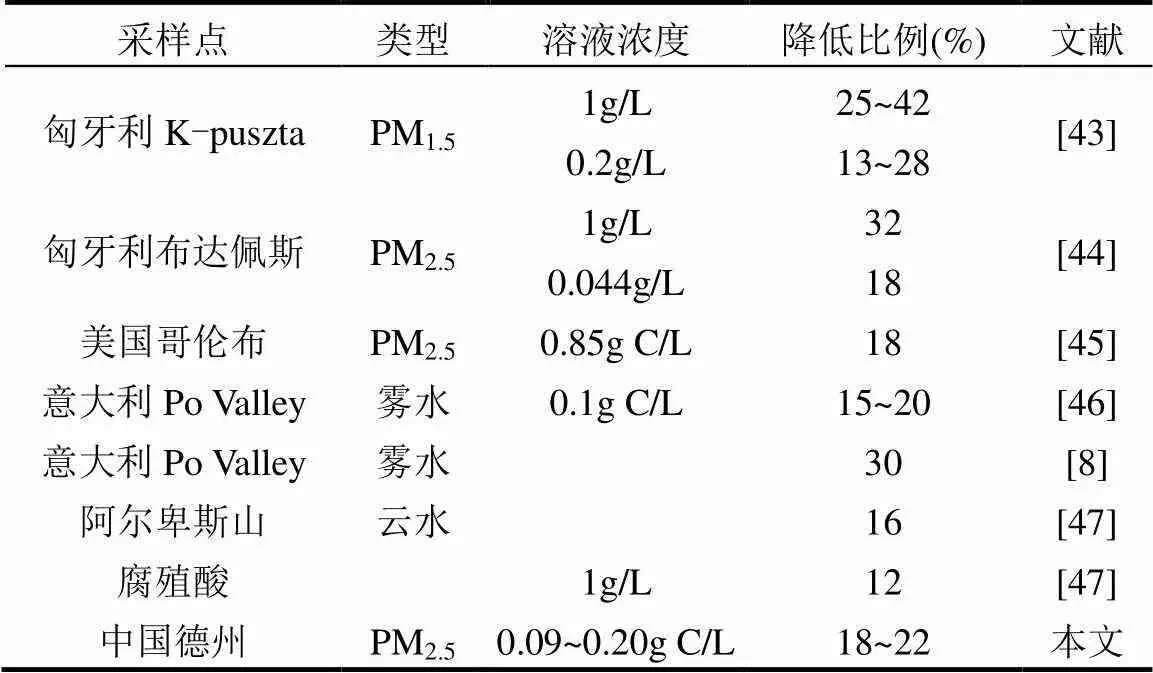PM2.5中类腐殖质表面活性测定方法与实例分析
2019-08-28吴志军刘玥晨王玉珏
白 瑶,吴志军,刘玥晨,王玉珏,郭 松,胡 敏
PM2.5中类腐殖质表面活性测定方法与实例分析
白 瑶,吴志军*,刘玥晨,王玉珏,郭 松,胡 敏
(北京大学环境科学与工程学院,环境模拟与污染控制国家重点联合实验室,北京 100871)
建立了大气细粒子中类腐殖质(HULIS)表面活性的动态表征方法,并以华北平原乡村站点冬季大气PM2.5样品为例,对PM2.5中HULIS的表面活性进行表征.HULIS碳质组分(HULIS-C)浓度为2.0~4.6μg C/m3,占水溶性有机碳和总有机碳的比例分别为31%~40%和20%~26%.浓度为88~200mg C/L的HULIS水溶液,其表面张力相对于纯水降低了18%~22%.HULIS-C浓度在低于70mg C/L时表面张力降低显著,在88~320mg C/L之间降低相对缓慢.动态表面张力随着时间变化逐渐降低,在液滴形成后200s以内表面张力下降迅速,之后趋于平缓,说明表面活性分子在液滴中扩散趋于稳定需要一定的时间,该特征时间可能影响表面活性物质在云凝结核活化时的作用.证实了在污染地区的大气PM2.5中含有一定量的表面活性物质,这些物质可能对颗粒物活化为云滴、雾滴过程产生显著影响;表面活性物质的存在可能在外界湿度变化过程中导致颗粒物发生液-液相分离现象,在颗粒物表面形成有机膜,影响活性分子摄取以及半挥发性物质的气-粒分配过程,从而影响大气非均相反应过程.
表面活性物质;表面张力;类腐殖质;大气细粒子
目前,人们对气溶胶与云相互作用的认识有限,不能精确预测全球和区域尺度的气候变化[1].大气气溶胶中可溶性无机组分如硫酸盐、硝酸盐、铵盐等对云凝结核(CCN)活化成为云滴的影响得到了广泛的研究[2-3],但有机物质与水相互作用的机制还不清楚[4].有机物成分复杂,占颗粒物总质量的20%~ 90%[5],需要进一步研究有机物的理化性质以厘清它们在云滴形成过程中的角色.
描述云滴的形成和生长的寇拉理论考虑到颗粒物的化学组分和粒径对颗粒物吸湿活化的影响,分为溶质效应和开尔文效应.表面张力是开尔文效应中的一个重要参数,表面张力的降低可能会降低液滴活化的临界过饱和度,形成更多的云滴[6],这可能导致云的生命周期延长,从而增强云的反照率[7-8].为了简化寇拉理论的应用,基于寇拉理论发展的к-Köhler理论考虑化学组分对水活度的影响并忽略表面张力效应[9-11].然而最近的研究[12-13]提出表面活性物质除了作为溶质影响水活度外,其表面活性也会影响CCN活性,这意味着目前的计算方法可能还不够准确.进一步的优化模型可通过测定不同浓度的表面张力获得经验公式,结合计算[14-15]或测量[9]的水活度输入寇拉方程模拟颗粒的吸湿活化.
表面活性物质含有亲水基团和疏水碳链,倾向于分布在液滴表面.一方面降低液滴的表面张力,影响成云活性.另一方面阻碍痕量气体和水的吸收,影响气溶胶的非均相反应过程[16-17].大气颗粒物中的表面活性物质包括有机酸、二元酸、蛋白质和类腐殖质(HULIS)[18-19]等.HULIS是一类多官能团的大分子有机物[20],从城市农村、森林、海洋采集的颗粒物中都检测到HULIS[21-22].目前针对HULIS的研究主要集中在化学组分、浓度水平及其来源解析上[23-25],对HULIS的表面活性以及对颗粒物成云活性影响的研究十分有限.另外,部分研究选用模型化合物替代实际环境HULIS进行分析[9,26],这些物质可能也无法完全代表实际环境下HULIS的性质,不足以作为HULIS的表面张力参数输入寇拉方程.因此,进一步研究实际大气环境下HULIS的表面活性并优化现有模型具有重要价值.尤其是我国雾霾的发生与颗粒物吸湿增长消光和活化成为雾滴的过程密切相关,对HULIS的表面活性研究有助于揭示雾霾形成机制.
为表征我国实际大气颗粒物中HULIS的表面活性,本研究建立了系统的HULIS水溶液表面张力测定方法,以一次冬季观测大气PM2.5样品为例表征大气颗粒物中HULIS的表面活性.
1 HULIS表面活性测定方法
HULIS表面活性的测定方法可以分为大气颗粒物采集、颗粒物质量浓度分析、超声提取以及固相萃取HULIS、碳质组分分析、表面张力测定.采集后的PM2.5样品进行颗粒物质量浓度分析和碳质组分分析.其后样品进行超声水提测定总水溶性有机碳(WSOC)浓度,使用固相萃取法提取样品中的HULIS,并测定其中HULIS-C浓度,得到HULIS-C占总水溶性有机碳和有机碳的比例,最后测定HULIS水溶液的表面张力.具体操作步骤如下.
1.1 PM2.5样品采集
本研究使用流量为1050L/min的大流量采样器(TH-1000,武汉天虹公司)和流量为16.7L/min的TH-16A大气颗粒物智能采样器(武汉天虹公司)采集PM2.5样品,分别配备石英纤维滤膜(Whatman Inc., 203mm×254mm)和Teflon膜(Whatman Inc,USA, 47mm).其中Teflon膜采集的样品用于膜称重,石英纤维滤膜采集的样品用于元素碳、有机碳以及HULIS组分分析.石英纤维滤膜在采样前置于洁净铝箔中,在马弗炉(550℃)中灼烧5.5h去除其中的有机物.采样用的镊子和棉花在使用前用二氯甲烷超声清洗3次.采样器和切割头也在采样前完成流量标定和清洗,采样后的样品置于冷藏柜冷冻保存(−20℃),采样期间记录采样时间、采样流量和天气等参数.
1.2 颗粒物质量浓度分析
将Teflon膜置于超净实验室恒温恒湿(温度:(20±1)℃,相对湿度:(40±5)%)平衡24h后,用十万分之一天平(AX105DR型,瑞士Mettler Toledo公司)称重,并根据采样前后样品的质量差除以采样体积计算颗粒物的质量浓度.
1.3 HULIS提取
本研究采用固相萃取法提取HULIS,主要包括3个步骤:(1)超纯水超声提取;(2)固相萃取分离和浓缩HULIS组分;(3)洗脱目标物.
在大流量采样膜上切一个Φ47mm的圆形样品放于提取罐中,用20mL去离子水(Milli-Q Gradient, Millipore Company,美国)超声提取40min(防止水温过高,每20min向超声仪中换冰水).其后用0.45μm PTFE微孔滤膜过滤提取液,除去不溶性颗粒和杂物,收集滤液;取出2mL稀释至10mL用于测定水溶性有机碳浓度;用2.4mol/L盐酸将剩余提取液酸化至pH=2.使用固相萃取柱(DSC-18,Sigma-Aldrich,USA)分离和富集HULIS,用3mL甲醇活化柱子、3mL去离子水和1mL 0.01mol/L盐酸分别对萃取柱活化、清洗、平衡;将酸化后的提取液过柱,经固相萃取,水溶液中的无机组分、极性较强的低分子量有机酸和糖类未被保留[27],极性相对较弱的有机组分被填充物保留.样品加完后用2mL去离子水清洗柱子2次,以除去填充柱中的残留提取液;用1.5mL甲醇洗脱下被SPE小柱保留的组分,即为HULIS.将洗脱液用高纯氮气吹干,用1.5mL去离子水再溶解HULIS,取0.5mL稀释至10mL用于测定HULIS-C的浓度,另外1mL用于表面张力测定.Lin等[28]选用HULIS的替代物SRFA和NAFA测定提取方法的回收率分别为94%和92%.关于SPE步骤的具体讨论详见文献[29].
1.4 PM2.5中含碳组分测定
使用美国Sunset Laboratory 的碳分析仪分析石英纤维滤膜上采集的有机碳(OC)和元素碳(EC),分析方法为热光透射法(NIOSH5040),仪器最低检出限为0.2μg/m2,仪器精密度为±5%,具体仪器分析原理、分析方法和质量控制详见文献[30].
采用日本岛津公司总有机碳分析仪(TOC- LCPH)测定样品溶液总水溶性有机碳(WSOC)浓度和HULIS-C浓度.由于样品量有限(10mL),本研究采用NPOC法测定,样品先经酸化曝气除去无机碳,注入燃烧管在高温条件下氧化为CO2,再用检测器测量CO2浓度.每个样品测定2次,差值大于3%进行第3次测定.测量样品前先测定配制好的标液,当测量结果与实际浓度差值在5%以内可进行样品水溶性有机碳测定.
1.5 表面张力测定
本研究选用悬滴法测量HULIS溶液的动态表面张力,悬滴法的优点是用量少,适合测定含量较低的实际大气样品[14].此外,该方法不仅可以获得表面张力的平衡值,还可以捕捉到表面活性物质分布到液滴表面的变化过程[26].
本研究测定仪器(Krüss DSA30)主要包括液滴形成系统、照明系统、温度控制系统、成像系统以及计算机计算系统.采用1mL一次性注射器和(1.812±0.02)mm的针头,测量时将注射器安装在进样器上使之插入一个封闭温控腔内,在注射器针头形成液滴直到增大到快要掉落达到最大稳定体积.照明系统在温控箱的一侧产生均匀照明的背景.温度控制系统主要由控温箱,温度传感器和恒温水槽组成,本研究测定温度为(20±0.3)℃.悬挂的液滴图像由一个配置了显微镜镜头的相机记录.实验过程中保留2~3mm长度的针头,使针头与液滴在同一画面内以便对液滴图像放大倍率进行校准,悬滴连同针头的图像被采集到同一画面内(见图1),在稳定的光源下呈现出清晰的图像,计算机将图像数字化得到液滴的形状因子和半径,使用公式1获得液滴表面张力值,计算方法为:

式中:为液滴的表面张力(mN/m);Δ为液滴与周围气相相差的密度(g/cm3);为重力加速度(N/kg);d为液滴半径(mm);为液滴形状因子.溶液的密度用分析天平测定(AX105DR型,瑞士Mettler Toledo公司).液滴形成稳定后,每隔5s拍一张照,记录15~ 20min,之前有研究报道动态测定时长为10min[4],本研究在此基础上多测量5~10min.
使用超纯水对仪器进行校准,测定9次,每次20min,液滴形成相同时间下9个测量值的相对标准偏差为0.61%~0.88%,测定过程中液滴的体积变化<5%.每次测定样品表面张力前先测定超纯水的表面张力,与理论值差值小于5%,进行样品表面张力测定,每个样品测定3次.

图1 悬滴示意
2 实例分析
本研究采样点位于山东德州平原县气象局(37.09°N,116.26°E).于2017年12月13日~12月20日共采集了7套大气环境PM2.5样品,采样时间为早晨8:30~次日8:00.12月21号采集空白样品,将石英膜放置在采样器上不开泵采集30min.
2.1 颗粒物质量浓度和碳质组分浓度

表1 HULIS-C、WSOC和OC的浓度
碳质组分浓度如表1所示,HULIS占 WSOC的31%~40%,可见HULIS在水溶性有机碳组分中占重要比例.
表2为研究报道的生物质燃烧排放颗粒物、城市和乡村大气颗粒物中HULIS的浓度及其在WSOC和OC中的占比.根据换算系数HULIS/ HULIS-C=1.94[28],本研究HULIS的浓度为3.9~ 8.9μg/m3,略高于欧洲地区和西藏地区,与珠江三角洲和上海相近,低于巴西地区.HULIS-C对WSOC的贡献在15%~74%之间,对OC的贡献范围在5%~51%之间,测定结果在报道研究的范围内,较宽的变化范围可能由于HULIS的来源、形成途径和老化程度不同造成.采样期间PM2.5浓度为66.5~125.0μg/m3, HULIS占PM2.5的6%~10%,该比例与我国广东玉米秸秆(11.2±7.5)%和松树枝(11.4±3.8)%燃烧排放颗粒物的测量结果[31]及珠江三角洲地区环境大气颗粒的测量结果(11.7±2.1)%相近[28].

表2 不同环境大气颗粒物中HULIS浓度及其对WSOC、OC的贡献
2.2 HULIS溶液表面张力
本研究测定20℃下超纯水的表面张力均值为72.3mN/m,空白样品HULIS碳浓度为2mg C/L,表面张力均值为71.9mN/m,两者都与理论值72.8mN/m相差很小,说明测定的表面张力结果可信且提取过程未影响目标物的表面张力.各采样日HULIS溶液的表面张力如图2所示,浓度为88~200mg C/L的HULIS溶液的表面张力在液滴形成20min后为56.7~59.4mN/m,与纯水的表面张力相比降低了18%~22%.液滴表面张力的降低程度与HULIS含量并未呈现单调的递增或递减,不同天样品的HULIS溶液表面张力有细微差别.
液滴形成后,表面张力呈现出随着时间变化逐渐降低接近平衡值,前200s表面张力值降低迅速,之后趋于平缓,说明表面活性分子在液滴中扩散趋于稳定需要一定的时间.Nozièr等[32]测定大气PM10中的表面活性物质的动态表面张力达到平衡时为30~50mN/m,表面张力快速下降的时间范围为8~110s,达到平衡的时间为36~495s,本研究的样品表面张力变化的时间尺度与该报道相似.研究还指出表面活性剂对低云或层云等垂直上升气流缓慢的云的形成影响较大,测量结果显示表面活性物质的表面张力达到平衡的时间在这类云的形成时间范围内(1~30min),这将有助于云滴的形成.
不同浓度的HULIS溶液其液滴在形成15min后的表面张力变化如图3所示.随着HULIS溶液浓度增加,其表面张力降低,HULIS-C浓度在低于70mg C/L时表面张力降低迅速,88~320mg C/L之间表面张力降低相对缓慢.
结果表明华北平原污染环境大气颗粒物中含有表面活性物质.表面活性物质的存在可能影响颗粒物的吸湿增长,降低其活化的饱和蒸汽压,进而直接影响大气颗粒物成为雾滴和云滴的活化过程.在未来研究中可将测定的HULIS溶液的表面张力输入寇拉方程,量化HULIS的表面活性对液滴吸湿活化的影响.其次,在环境大气湿度变化过程中,表面活性物质的存在可能使得颗粒物出现液-液相分离,形成核壳结构,影响对活性分子的摄取,从而影响大气多相化学过程,未来研究可测定HULIS颗粒在不同相对湿度下的形貌,在高相对湿度下是否发生液-液相分离现象.

图2 HULIS液滴动态表面张力

图3 不同HULIS-C溶液表面张力
2.3 不同环境含碳物质表面活性比较
目前,关于实际大气颗粒物中表面活性物质表面张力的研究十分有限,表3为不同环境大气样品中表面活性物质表征的结果.与纯水相比实际大气样品中表面张力降低范围在15%~42%,表面张力受有机物浓度、液滴酸度、温度、金属离子等因素影响[42].Kiss等[43]研究发现乡村环境大气颗粒物中HULIS在溶液浓度为1g/L时,与纯水相比其表面张力降低25%~ 42%,浓度为0.2g/L时,其表面张力降低13%~28%.样品的表面活性呈现季节性的变化特征,不同季节样品的元素组成相似时,表面张力变化是由官能团的位置、链长度、芳香性等引起的.Salma等[44]测量显示城市环境大气(布达佩斯)HULIS液滴在1g/L和44mg/L浓度下表面张力与纯水表面张力相比分别降低32%和18%,动态表面张力结果显示高浓度的HULIS溶液的表面张力达到平衡值所需的时间更短.Asa-Awuku等[45]报道了浓度0.85g C/L的生物质燃烧颗粒物的水提液与纯水相比表面张力降低18%.Facchini等[46]测定意大利雾水样品中的WSOC浓度为0.1g C/L时表面张力降低15%~20%.将水溶性有机物分成中性化合物、单羧酸和多元羧酸3类,其中多元羧酸(类腐殖质)的浓度最低,但是表面活性最强.实际测量的云水和雾滴的表面张力与纯水相比,分别降低了16%和30%,计算表明表面张力降低30%将导致云滴数量增加20%[8,47].标准腐殖酸对液滴表面张力的降低程度比大气颗粒物中HULIS低7%~23%[43].腐殖酸浓度为1g/L时,表面张力仅降低12%[48].本研究HULIS溶液浓度为0.09~ 0.20g C/L时与纯水相比表面张力降低18%~22%,与匈牙利K-puszta、布达佩斯和意大利等地测量结果接近,比美国哥伦布生物质燃烧颗粒的表面活性更显著.

表3 实际大气样品表面张力测量结果
3 结论
3.1 建立了大气颗粒物中HULIS动态表面活性的测定流程与方法.以华北地区乡村站点冬季大气PM2.5样品为例,基于上述方法对PM2.5中HULIS含量和表面活性进行表征.测量结果显示HULIS-C的浓度为2.0~4.6μg C/m3,分别占WSOC和OC的31%~40%和20%~26%.浓度在88~200mg C/L的HULIS水溶液的表面张力在液滴形成20min后数值范围为56.7~59.4mN/m,与纯水的表面张力相比降低了18%~22%.
3.2 动态表面测量显示HULIS液滴表面张力随着时间变化逐渐降低,前200s下降迅速,之后趋于平缓.
3.3 HULIS-C浓度低于70mg C/L时表面张力降低显著,88~320mg C/L之间表面张力降低相对缓慢.
[1] Forster P, Ramaswamy V, Artaxo P, et al. Changes in Atmospheric Constituents in Radiative Forcing [M]. United Kingdom and New York: Cambridge University Press, 2007:171-180.
[2] Pitchford M L, Mcmurry P H. Relationship between measured water vapor growth and chemistry of atmospheric aerosol for Grand Canyon, Arizona, in winter 1990 [J]. Atmospheric Environment, 1994,28(5): 827-839.
[3] Svenningsson B, Hansson H, Wiedensohler A, et al. Hygroscopic growth of aerosol particles and its influence on nucleation scavenging in cloud: Experimental results from Kleiner Feldberg [J]. Journal of Atmospheric Chemistry, 1994,19(1):129-152.
[4] Gray Bé A, Upshur M A, Liu P, et al. Cloud Activation Potentials for Atmospheric α-Pinene and β-Caryophyllene Ozonolysis Products [J]. ACS central science, 2017,3(7):715-725.
[5] Jimenez J L, Canagaratna M R, Donahue N M, et al. Evolution of Organic Aerosols in the Atmosphere [J]. Science, 2009,326(5959): 1525.
[6] Sareen N, Schwier A N, Lathem T L, et al. Surfactants from the gas phase may promote cloud droplet formation [J]. Proceedings of the National Academy of Sciences, 2013,110(8):2723.
[7] Lo J A, Lee W G. Effect of surfactant film on solubility of hydrophobic organic compounds in fog droplets [J]. Chemosphere, 1996,33(7):1391-1408.
[8] Facchini M C, Mircea M, Fuzzi S, et al. Cloud albedo enhancement by surface-active organic solutes in growing droplets [J]. Nature, 1999,401:257.
[9] Kristensen T B, Prisle N L, Bilde M. Cloud droplet activation of mixed model HULIS and NaCl particles: Experimental results and κ-Köhler theory [J]. Atmospheric Research, 2014,137:167-175.
[10] Petters M D, Kreidenweis S M. A single parameter representation of hygroscopic growth and cloud condensation nucleus activity [J]. Atmospheric Chemistry and Physics, 2007,7(8):1961-1971.
[11] Sorjamaa R, Svenningsson B, Raatikainen T, et al. The role of surfactants in Köhler theory reconsidered [J]. Atmospheric Chemistry and Physics, 2004,4(8):2107-2117.
[12] Ovadnevaite J, Zuend A, Laaksonen A, et al. Surface tension prevails over solute effect in organic-influenced cloud droplet activation [J]. Nature, 2017,546:637.
[13] Ruehl C R, Davies J F, Wilson K R. An interfacial mechanism for cloud droplet formation on organic aerosols [J]. Science, 2016, 351(6280):1447.
[14] Wex H, Stratmann F, Hennig T, et al. Connecting hygroscopic growth at high humidities to cloud activation for different particle types [J]. Environmental Research Letters, 2008,3(3):35004.
[15] Giordano M R, Short D Z, Hosseini S, et al. Changes in Droplet Surface Tension Affect the Observed Hygroscopicity of Photochemically Aged Biomass Burning Aerosol [J]. Environmental Science & Technology, 2013,47(19):10980-10986.
[16] Andrews E, Larson S M. Effect of surfactant layers on the size changes of aerosol particles as a function of relative humidity [J]. Environmental Science & Technology, 2002,27(5):857-865.
[17] Latif M T, Brimblecombe P. Surfactants in Atmospheric Aerosols [J]. Environmental Science & Technology, 2004,38(24):6501-6506.
[18] Schwier A N, Viglione G A, Li Z, et al. Modeling the surface tension of complex, reactive organic–inorganic mixtures [J]. Atmospheric Chemistry and Physics, 2013,13(21):10721-10732.
[19] Mircea M, Facchini M C, Decesari S, et al. The influence of the organic aerosol component on CCN supersaturation spectra for different aerosol types [J]. Tellus B, 2002,54(1):74-81.
[20] Kiss G, Varga B, Galambos I, et al. Characterization of water-soluble organic matter isolated from atmospheric fine aerosol [J]. Journal of Geophysical Research: Atmospheres, 2002,107(D21):1.
[21] Kristensen T B, Wex H, Nekat B, et al. Hygroscopic growth and CCN activity of HULIS from different environments [J]. Journal of Geophysical Research: Atmospheres, 2012,117(D22):203.
[22] Feczko T, Puxbaum H, Kasper-Giebl A, et al. Determination of water and alkaline extractable atmospheric humic-like substances with the TU Vienna HULIS analyzer in samples from six background sites in Europe [J]. Journal of Geophysical Research: Atmospheres, 2007,112 (D23):S10.
[23] Wang Y, Hu M, Lin P, et al. Molecular Characterization of Nitrogen- Containing Organic Compounds in Humic-like Substances Emitted from Straw Residue Burning [J]. Environmental Science & Technology, 2017,51(11):5951-5961.
[24] Wu G, Wan X, Gao S, et al. Humic-Like Substances (HULIS) in Aerosols of Central Tibetan Plateau (Nam Co, 4730m asl): Abundance, Light Absorption Properties, and Sources [J]. Environmental Science & Technology, 2018,52(13):7203-7211.
[25] Graber E R, Rudich Y. Atmospheric HULIS: How humic-like are they? A comprehensive and critical review [J]. Atmospheric Chemistry and Physics, 2006,6(3):729-753.
[26] Prisle N L, Molgaard B. Modeling CCN activity of chemically unresolved model HULIS, including surface tension, non-ideality, and surface partitioning [J]. Atmospheric Chemistry and Physics Discussion, 2018,2018:1-23.
[27] Varga I, Keszthelyi T, Mészáros R, et al. Observation of a Liquid−Gas Phase Transition in Monolayers of Alkyltrimethylammonium Alkyl Sulfates Adsorbed at the Air/Water Interface [J]. The Journal of Physical Chemistry B, 2005,109(2):872-878.
[28] Lin P, Huang X, He L, et al. Abundance and size distribution of HULIS in ambient aerosols at a rural site in South China [J]. Journal of Aerosol Science, 2010,41(1):74-87.
[29] Varga B, Kiss G, Ganszky I, et al. Isolation of water-soluble organic matter from atmospheric aerosol [J]. Talanta, 2001,55(3):561-572.
[30] Huan N, Zeng L, Shao M, et al. Measurement and Discussion of Carbonaceous PM2.5during Winter in Beijing [J]. Acta Scientiarum Naturaiium Universitatis Pekinensis, 2006,42(2):265-270.
[31] Fan X, Wei S, Zhu M, et al. Comprehensive characterization of humic-like substances in smoke PM2.5emitted from the combustion of biomass materials and fossil fuels [J]. Atmospheric Chemistry and Physics, 2016,16(20):13321-13340.
[32] Nozière B, Baduel C, Jaffrezo J. The dynamic surface tension of atmospheric aerosol surfactants reveals new aspects of cloud activation [J]. Nature Communications, 2014,5:3335.
[33] Baduel C, Voisin D, Jaffrezo J L. Seasonal variations of concentrations and optical properties of water soluble HULIS collected in urban environments [J]. Atmospheric Chemistry and Physics, 2010,10(9):4085-4095.
[34] Limbeck A, Handler M, Neuberger B, et al. Carbon-Specific Analysis of Humic-like Substances in Atmospheric Aerosol and Precipitation Samples [J]. Analytical Chemistry, 2005,77(22):7288-7293.
[35] Salma I, Ocskay R, Chi X, et al. Sampling artefacts, concentration and chemical composition of fine water-soluble organic carbon and humic-like substances in a continental urban atmospheric environment [J]. Atmospheric Environment, 2007,41(19):4106-4118.
[36] Decesari S, Facchini M C, Matta E, et al. Chemical features and seasonal variation of fine aerosol water-soluble organic compounds in the Po Valley, Italy [J]. Atmospheric Environment, 2001,35(21): 3691-3699.
[37] Cavalli F, Facchini M C, Decesari S, et al. Size-segregated aerosol chemical composition at a boreal site in southern Finland, during the QUEST project [J]. Atmospheric Chemistry and Physics, 2006,6(4): 993-1002.
[38] Mayol-Bracero O L, Guyon P, Graham B, et al. Water-soluble organic compounds in biomass burning aerosols over Amazonia 2. Apportionment of the chemical composition and importance of the polyacidic fraction [J]. Journal of Geophysical Research: Atmospheres, 2002,107(D20):59.
[39] Krivácsy Z, Kiss G, Ceburnis D, et al. Study of water-soluble atmospheric humic matter in urban and marine environments [J]. Atmospheric Research, 2008,87(1):1-12.
[40] Qiao T, Zhao M, Xiu G, et al. Seasonal variations of water soluble composition (WSOC, Hulis and WSIIs) in PM1and its implications on haze pollution in urban Shanghai, China [J]. Atmospheric Environment, 2015,123:306-314.
[41] Salma I, Mészáros T, Maenhaut W, et al. Chirality and the origin of atmospheric humic-like substances [J]. Atmospheric Chemistry and Physics, 2010,10(3):1315-1327.
[42] Mcneill V F, Sareen N, Schwier A N. Surface-active organics in atmospheric aerosols [J]. Topics in current chemistry, 2014,339:201- 259.
[43] Kiss G, Tombácz E, Hansson H. Surface Tension Effects of Humic-Like Substances in the Aqueous Extract of Tropospheric Fine Aerosol [J]. Journal of Atmospheric Chemistry, 2005,50(3):279-294.
[44] Salma I, Ocskay R, Varga I, et al. Surface tension of atmospheric humic-like substances in connection with relaxation, dilution, and solution pH [J]. Journal of Geophysical Research: Atmospheres, 2006, 111(D23):205.
[45] Asa-Awuku A, Sullivan A P, Hennigan C J, et al. Investigation of molar volume and surfactant characteristics of water-soluble organic compounds in biomass burning aerosol [J]. Atmospheric Chemistry and Physics, 2008,8(4):799-812.
[46] Facchini M C, Decesari S, Mircea M, et al. Surface tension of atmospheric wet aerosol and cloud/fog droplets in relation to their organic carbon content and chemical composition [J]. Atmospheric Environment, 2000,34(28):4853-4857.
[47] Hitzenberger R, Berner A, Kasper-Giebl A, et al. Surface tension of Rax cloud water and its relation to the concentration of organic material [J]. Journal of Geophysical Research: Atmospheres, 2002, 107(D24):5.
[48] Klavins M, Purmalis O. Humic substances as surfactants [J]. Environmental Chemistry Letters, 2010,8(4):349-354.
The surface activity of humic-like substances: methodology and case study.
BAI Yao, WU Zhi-jun*, LIU Yue-chen, WANG Yu-jue, GUO Song, HU Min
(State Key Joint Laboratory of Environmental Simulation and Pollution Control, College of Environmental Sciences and Engineering, Peking University, Beijing 100871, China)., 2019,39(8):3137~3143
A dynamic methodology was developed to characterize the surface activity of water soluble humic-like substances (HULIS) in PM2.5.As a case study, HULIS in PM2.5samples collected from a rural site during wintertime in North China Plain region were investigated. The HULIS carbon content varied from 2.0~4.6μg C/m3, accounting for 31%~40% of water-soluble organic carbon and 20%~26% of organic carbon, respectively. While the carbon content of HULIS aqueous solution ranged from 88~200mg C/L, correspondingly, the surface tension reduced by 18%~22% compared with that of pure water. The surface tension decreased significantly when the concentration was lower than 70mg C/L, while it decreased slowly between 88~320mg C/L. The dynamic measurements showed that surface tension gradually decreased with time consuming. Surface tension decreased rapidly within 200 seconds after droplet formation and then tended to be stable, indicating that the distribution of surface-active organic molecules onto the droplet surface was not instantaneous. Such process may affect droplet activation. There were substantial surface-active substances in atmospheric particulate matters in the polluted atmosphere. These surfactants may have significant impacts on the activation of aerosol particles into cloud or fog droplets. In addition, the HULIS may lead to liquid-liquid phase separation and form the core-shell structure of particles when ambient relative humidly fluctuates. Such structure could influence the uptake of reactive molecules and the gas-particle partitioning, therefore, affecting heterogeneous chemistry.
surfactants;surface tension;humic-like substances;PM2.5
X513
A
1000-6923(2019)08-3137-07
白 瑶(1993-),女,云南红河人,北京大学硕士研究生,主要从事大气颗粒物中类腐殖质的表面活性研究.
2019-01-02
国家自然科学基金国际(地区)合作与交流项目(41571130021, 41875149) ;国家重点研发计划(2016YFC0202801)
* 责任作者, 研究员, zhijunwu@pku.edu.cn
